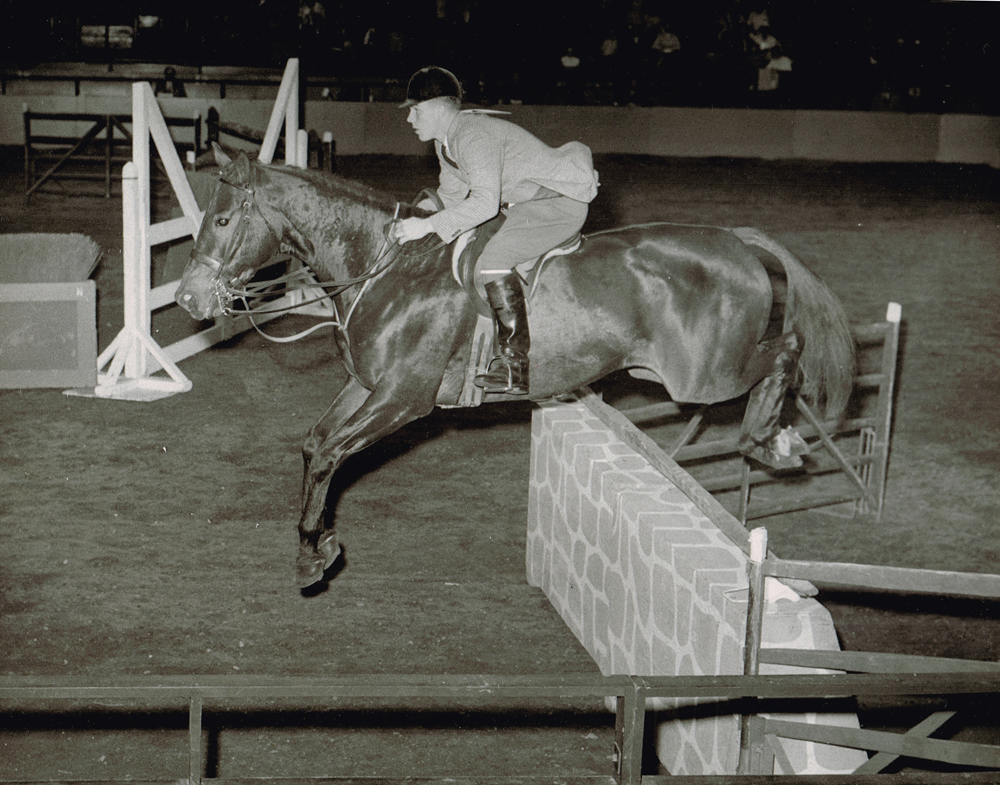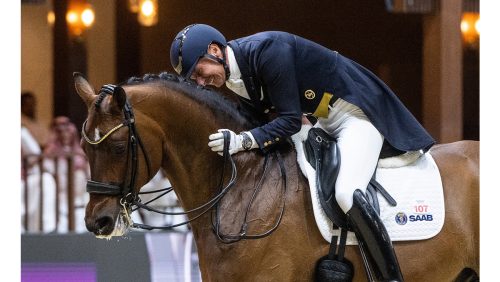Mike Plumb is known as one of the living legends of eventing, having represented the United States on multiple teams beginning with the Pan American Games in Chicago in 1959.
But did you know that only two years prior, Plumb was a winning junior equitation rider, and hadn’t even set foot on a cross-country course?

Mike Plumb showing in the junior hunters at age 12 on Long Island.
In fact, a 17-year-old Plumb won the 1957 ASPCA Maclay Championship and placed second in the American Horse Shows Association hunter seat medal final (now the USEF Medal) at Madison Square Garden. He was also second in the Maclay and third in the Medal Finals in 1955.
Plumb grew up on Long Island surrounded by horses. His father, Charles Plumb Sr., was an accomplished steeplechase jockey and foxhunter, serving as huntsman for the Meadowbrook Hounds (N.Y.), while his mother Mary often served as whipper-in.
“We went to horse shows every weekend,” he said. “If we weren’t horseshowing, I was hunting with my dad. I was showing at Stonybrook and Rice Farms and various horse shows in the area. It was a great era as I remember, and I was so lucky to be a part of it. I’m still appreciative of it all.”
Riding at the National Horse Show at Madison Square Garden was a big deal for Mike, and for the 1957 equitation championships, he wanted to go for the win.
“For me, that was the big time—Madison Square Garden,” he said. “I showed there a couple of years prior to that but that was the pinnacle. That was the Olympic Games for me then to be there. That was the main horse show in the world for me. The big time.”
Mike trained with Victor Hugo Vidal and General John T. Cole, who would later set him on a course toward eventing. “Victor was a big part of my equitation life. I went to shows with him and he was a real mentor,” he said.
ADVERTISEMENT
Mike’s mount for the 1957 Maclay was the Thoroughbred Toors End, who came to his family via the famous hunter rider David T. Kelley.
“My dad was a horse trader and a wonderful horseman,” he said. “I’d been to Madison Square Garden a couple of times before on lesser horses, but he wanted to get me a good one. During those days, for us, a $2,500 horse was a big deal.
“My dad somehow got a hold of [Dave Kelley],” he continued. “That was a big deal. There was only one problem with this horse, he was a terrible bucking horse. My dad believed in those days that the way to deal with bucking horses was to foxhunt them, and he would foxhunt them every day if had to, to get the buck out. We would get horses in and he was the fixer. If there was a problem, he could fix anything.”
Mike recalled that his father foxhunted the gelding from Monday through Thursday the week of the show, then shipped him to the show after hunting on Thursday.
There wasn’t an opportunity for juniors to get into the ring until the weekend, so Mike rode him in an appointments class on Friday.
“Dave Kelley was in the audience. Back during those days Otis Trowbridge was the announcer. All the riders and exhibitors used to sit underneath the announcer’s booth and watch their riders. I went in to the ring on this horse, and the house was packed Friday night at Madison Square Garden. That was scary, really scary because I was only 17,” he recalled.
“I got about halfway around the course, and that horse started bucking with me because that’s what he was. My dad had said, ‘He’ll be alright because I’ve hunted him every day.’ Well, it wasn’t alright! He unloaded me right at the end of the ring and the crowd and Dave Kelley thought that was so funny. I’ll never forget it. Long story short, the next day, he came back, and we won the Maclay.

Mike Plumb showing to the Maclay win in 1957 aboard Toors End at the National Horse Show in Madison Square Garden. Photo by Freudy
“That was a big day in my life because that horse was ornery, and my dad was a big part of it. It was just funny because I was young and at the time, nothing could hurt me. It just gave the crowd a big laugh and lots of applause.”
ADVERTISEMENT
Mike remembered the course as being “pretty straightforward” compared to today’s finals.
“It just doesn’t compare to what’s going on now. I was happy to get the correct lead,” he said. “I was blessed with some natural talent. I was blessed with being able to find the jumps. It was not a very complicated course, with all due respect. There weren’t a lot of related distances in those days and hell, I don’t even remember having to do a flying change. It was pretty primitive, but it was a big deal for me, I’ll tell you that. It was a lot of fun.
“I remember getting the trophy with all the names of previous owners,” he continued. “It was a huge plate with names all over it. I enjoyed beating [Michael Page, who won the 1956 AHSA Medal and would later become a star eventer for the United States]. He was sort of my age, maybe a little older than I am.”
Mike competed Toors End a few more times on Long Island before he transitioned to eventing the following year.
“I was heavy. I played football and basketball and baseball and at that time, it was kind of cool to be a big jock. For riding, you didn’t want to be a big jock, you wanted to be thin and not fat. I made a big point of that,” he said. “Somewhere along the line, myself, my family and Tupper Cole thought [eventing] would be a nice avenue for me because I was a good athlete and it would be sort of the next step.
“I don’t know why I really went and started eventing. I was good at that and probably could do what most equitation people do nowadays, which is go to the jumper route. I think it was a thing of money. I don’t think there were the finances to stay in the horse show routine. Civilian eventing was just starting then. It started out in Colorado Springs.”
Mike was invited to compete at an event at the Broadmoor Hotel in Colorado Springs, and the rest is history. He was discovered by the U.S. Equestrian Team in 1959 and served on the U.S. team at the Pan Ams, bringing home team and individual silver medals. He was hooked.
“During those days, it was different. It wasn’t that it was easy. I had some instinct and from my foxhunting experience, I liked to ride cross-country,” he said. “The cross-country jumps were a little bit archaic during those days. I just didn’t know any better—an ignorant big kid that had some talent and just went for it. Now I’m wiser, and I don’t know that I could now what they do. It’s so technical, which I think is great. I like the short format.”
Even after all of his achievements in eventing, Mike still looks back on his junior days with fondness and appreciates the skills the equitation division instilled in him.
“I like sharing those thoughts because it was all the beginning part of this road I’ve been down,” he said. “I’m so happy to have that experience behind me, because equitation for me is the foundation for all of whatever you want to be—an event rider, a jumper rider, a dressage rider, and I had it. I was much appreciative to my parents for giving me the chance and putting me in the right place at the right time.”














